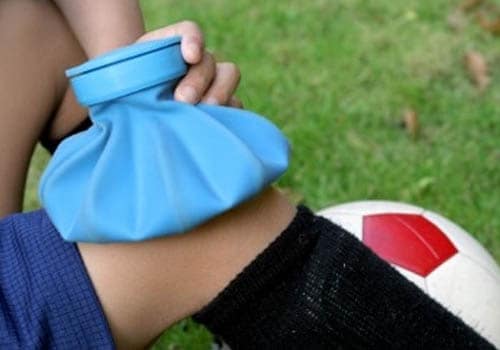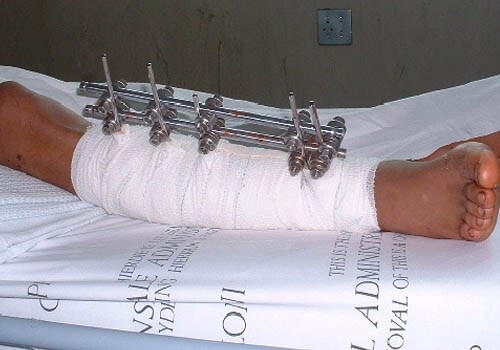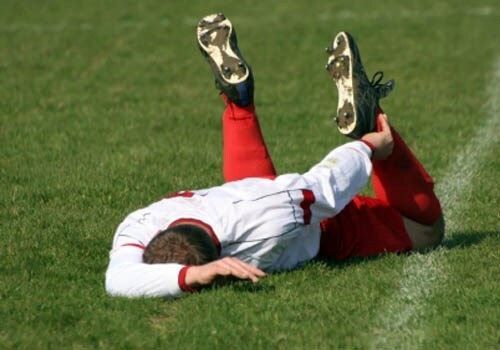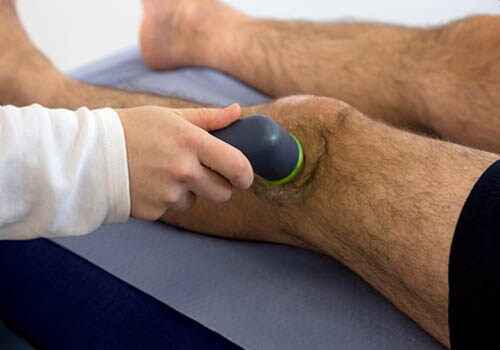-

What are sports injuries?
Sports injuries typically occur while participating in organised sports, competitions, training sessions, or organised fitness activities. These injuries may occur for a variety of reasons, including improper training, lack of appropriate footwear or safety equipment. The best way to deal with sports injuries is to prevent them. Prevention includes knowing the rules of the game one is playing, using the proper equipment, and playing safe.
-

What are the types?
Sports activities can result in injuries - some minor, some serious, and still others resulting in lifelong medical problems. There are two general types.
- Acute traumatic injury: Acute traumatic injuries usually involve a single blow from a single application of force. These injuries include the following:
- a fracture - a crack, break, or shattering of a bone
- a bruise - caused by a direct blow, which may cause swelling and bleeding in muscles and other body tissues
- a strain - a stretch or tear of a muscle or tendon, the tough and narrow end of a muscle that connects it to a bone
- a sprain - a stretch or tear of a ligament, the tissue that supports and strengthens joints by connecting bones and cartilage.
- a fracture - a crack, break, or shattering of a bone
- Overuse or chronic injury: Chronic injuries are those that happen over a period of time. Chronic injuries are usually the result of repetitive training, such as running, overhand throwing, or serving a ball in tennis. These include:
- stress fractures - tiny cracks in the bone's surface often caused by repetitive overloading (such as in the feet of a basketball player who is continuously jumping on the court).
- tendinitis - inflammation of the tendon caused by repetitive stretching.
- bursitis - an inflammation of the bursa, which is a small sac, in the shoulder, elbow, or knee.
- stress fractures - tiny cracks in the bone's surface often caused by repetitive overloading (such as in the feet of a basketball player who is continuously jumping on the court).
- Acute traumatic injury: Acute traumatic injuries usually involve a single blow from a single application of force. These injuries include the following:
-

What are the causes?
Head injuries include concussions, contusions, fractures, and haematomas. A concussion is a violent jarring or shock to the head that causes a temporary jolt to the brain. If severe enough, or recurrent, concussions can cause brain damage. A haematoma is a bleeding or pooling of blood between the tissue layers covering the brain or inside the brain. All of these injuries can be caused by impact to the head from a fall, forceful shaking of the head, a blow to the head, or whiplash. Whiplash is an injury to the neck caused by an abrupt jerking motion of the head. It is necessary to always wear helmets for contact sports and when doing activities like biking to prevent head injuries.
Neck injuries are among the most dangerous. One can hurt the neck through a sudden traumatic injury in sports like mountain climbing, skydiving, horseback riding, gymnastics, diving, or boxing. Neck injuries include strains, fractures, contusions, and sprains. Most neck injuries are caused by impact to the head or neck sustained during a fall or a blow. The neck can also be injured a little at a time. Too much strain on the neck can cause increasing pain, sometimes only on one side of the neck. If the injury is severe and there is a chance that the neck might be injured, it is very important to keep the injured person still with their head held straight while someone calls for emergency medical help.
Foot injuries can include ligament strains, stress fractures, heel bruises, and bursitis. Because one’s feet support all of the weight and must absorb a lot of force over and over again, they can be particularly susceptible to injury.
Sex Organs When it comes to injuries to the sex organs, boys and men usually suffer more trauma than girls because the penis and testicles are outside the body and lack natural protection during contact sports. They should always wear athletic supporters, or in some sports a cup, to protect the genitals from serious injury. Injuries to the uterus or ovaries are rare, but breast injuries are common complaints among girls. As the breasts develop, they can often be sore, and a blow from a softball or a jab from an elbow, can be painful. Girls should wear supportive sports bras while playing sports or exercising.
Back injuries include sprains, fractures, contusions, and strains and are caused by twists or overexertion of back muscles during bending or lifting movements. These injuries can occur in contact sports like football, weight lifting, skating, gymnastics, dancing, and basketball.
Hand injuries include fractures, dislocations, and sprains and often occur in contact sports such as football, hockey etc. Hand injuries can result from a fall that forces the hand or fingers backward, a forceful impact to the hands, or a direct blow. -

What is the treatment?
If the pain progressively increases with activity and causes any limping or loss of range of motion, one needs to see a doctor as soon as possible. The most important thing to do when one suspects injury is to stop doing whatever sport has caused the injury right away and see a doctor. For more severe or complicated injuries, it may be best to see a doctor who specialises in sports medicine. Once the doctor knows the full extent of the injury, he will start with conservative treatment techniques such as rest and ice to help decrease swelling. Pain relief and anti-inflammatory medicines such as ibuprofen may be prescribed. Splints, casts, and surgery also may be needed, depending on the injury. The doctor may recommend that one not play while the injury heals and to use protective devices.


















